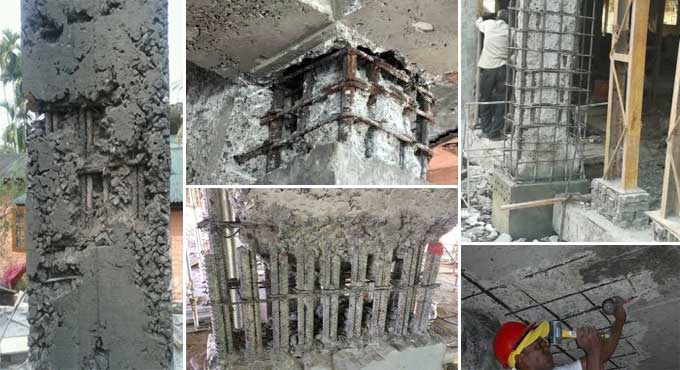
Honeycombing in RCC Structures - Causes, Prevention, and Repair
Honeycombing occurs when coarse aggregate is prominently visible on the surface of a concrete structure, which looks like a honeycomb.
Honeycombed surfaces are necessary to ensure the RCC structure performs adequately or is structurally strong. The voids created by the honeycombed surface can also allow in the passage of harmful agents such as contaminated water and air, significantly affecting the longevity of the structure. Several reasons result in their emergence, so they require immediate corrective and preventive measures.
Causes for Honeycombing
One or more of the following reasons may contribute to honeycombing in RCC structures.
- The mixture of concrete being incoherent.
- This is due to the insufficient workability of concrete.
- The concrete was not compacted enough.
- Concrete flow is hindered by steel congestion.
- Before placing concrete, it has already been set.
- Concrete falls freely while being poured.
- A rigid and watertight structure cannot be obtained.
- Steel details and fixings are incorrect.
Prevention for Honeycombing
1. The cohesiveness of all concrete batches must review regularly. As long as you can shape the fresh concrete into a ball, it is a cohesive mix.
For example, a lightweight reinforced column could have as little as a 75mm slump, while a heavily reinforced one could have a 150mm slump.
2. Make sure concrete is properly compacted, and remove vibrators as large air bubbles that cease to come out over vibration will result in bleeding. It is recommended to use different sizes of vibrator needles such as 25mm, 40mm, and 60mm in accordance with RCC sections.
3. In addition to compacting and working the corners, embedded fixtures and reinforcement should also fully work.
Concrete may suffer from honeycombing and 5% Voids during vibration, resulting in a 30% reduction in strength. Compact the formwork by covering it, pinning it, and adding spacers to the layers.
4. The slump should remain in concrete before it places. Concrete should also maintain its slump once it has been placed, in addition to the initial slump. You can reduce the height of the free-falling concrete by using a bucket with canvas pipes, concrete hose pipes, and other methods.
5. Water should not leak in from the formwork, and cement grout should not be lost during concrete placement. Detailed and fixed steel should be used to ease concrete follow-through across all depths and corners.
Steel congestion can't always be avoided, so special concrete formulations like self-compacting concrete, concrete with an aggregate size of 12.5mm, or low-strain concrete ought to be considered.
Procedure of Repairing Honeycomb
To accomplish this, use a chipper and hammer to remove loose concrete fragments, such as loose aggregates or mortar.
Use light and gradual pressure to avoid damaging virgin concrete around the perimeter, like using a breaker or electrical chipper. Utilizing an Injection pressure pump, fix the packer on the honeycombed surface, and fill the micro voids in the honeycomb surface with non- shrink epoxy grout.
The repaired grout is then repaired with self-curing mortar of equivalent compressive strength. You can buy repair mortar in different strength grades in the packaged form 15mm is the maximum thickness of the buildup.
That needs to treat using either micro concrete or concrete of an equivalent grade to the concrete used for an RCC structure if the voids are large or hollow pockets find. Various strengths and packages are available for micro concrete.
To get more details, watch the following video tutorial.
Video Source: Civil Mentors


